Tears That Brought Bamboo-shoots From the Frozen Earth: Meng Zong Meng Zong lived during the Three Kingdoms Period of China's past. His father died when he was young, and he and his mother struggled to survive. One winter his mother was stricken with a serious illness, and craved some bamboo-shoot broth as medicine. But in the depths of winter, with snow and ice blanketing the ground, where was anyone to find fresh bamboo shoots, shoots that emerge only in the warm months? Nonetheless, Meng Zong, to avoid disappointing his mother, bravely fetched his shovel and went out into the white landscape in search of bamboo shoots. In the thicket he found only frosted leaves and green stalks coated with snowflakes and ice. Look as he might, there were simply no fresh shoots growing in the winter. The thought of his poor mother lying sick on her bed, waiting for bamboo-broth medicine, made his heartache. Uncontrollably, tears began to fall in rivers to the ground beneath the tall, emerald canes. Even now, as his tears flowed down, he kept a light of faith in his heart. If he was truly sincere in his search, perhaps.... Just then Meng Zong nearly tripped and fell over a sharply protruding lump of earth. He quickly knelt down and knocked aside the dirt with his trembling fingers. How uncanny! Underneath his frozen hands he discovered a bed of fresh, tender bamboo shoots! Overjoyed, he gathered up a coatful and carried them back home. The broth that he quickly set stewing in the pot soon cured his mother's illness. The neighbors, hearing the story, exclaimed that it was the strength of his sincere, unselfish, filial resolve that inspired heaven and earth to respond, and to bring up, out of season, the fresh shoots that cured his mother's disease. Before Meng Zong's prayers generated this miracle, it was normally considered impossible for bamboo shoots to grow in the winter. After the nmiracle took place, however, people were able to gather and to eat bamboo shoots all year round. The winter variety that existed hereafter became known as "winter shoots." The villagers were deeply influenced by Meng Zong's courage and devotion. They renamed the spot where the event took place, "Meng Zong's Bamboo Grove". We can now enjoy bamboo sprouts during the winter as well, and as we do so, it is fitting to recollect Meng Zong's outstanding example of filial respect, and reflect on our conduct as sons and daughter of our parents. A verse in his honor says, His teardrops transformed winter at the roots; Up from the ice crept tender bamboo shoots. Instantly, the winter-sprouts matured; Heaven's will: a happy, peaceful world.
-
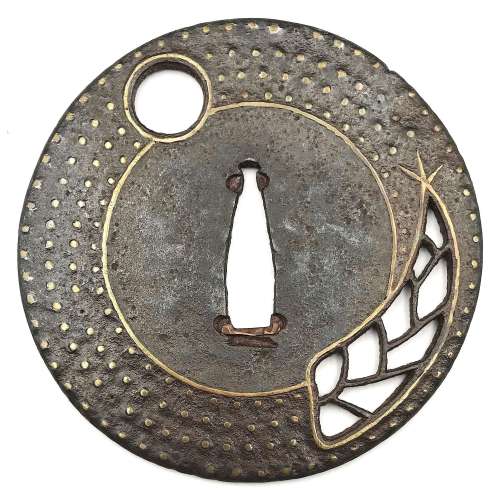 Ōnin shinchū ten-zōgan tsuba. Iron tsuba of round form decorated with full moon and bamboo shoot (takenoko) motif executed in openwork (sukashi) and inlaid with four concentric rows of brass dots (ten-zōgan). The innermost row of dots as well as the sukashi openings outlined with the inlaid linear brass wire. Late Muromachi period, 16th century. Diameter: 82.0 mm; Thickness: 2.8 mm Cited from Merrily Baird. Symbols of Japan. Thematic motifs in art and design. Rizzoli international publications, Inc., 2001, p. 72: "In Japanese art, the appearance of bamboo shoots is often without symbolic meaning. In other cases, however, the shoots are emblematic of Moso (Chinese: Meng Tsung/Meng Zong), a paragon of filial piety who dug through snow to find shoots for his mother. ... especially in miniature art forms, let bamboo shoots alone speak for the full story." The full story is this (See THE TWENTY-FOUR PARAGONS OF FILIAL PIETY [ERSHISI XIAO]):
Ōnin shinchū ten-zōgan tsuba. Iron tsuba of round form decorated with full moon and bamboo shoot (takenoko) motif executed in openwork (sukashi) and inlaid with four concentric rows of brass dots (ten-zōgan). The innermost row of dots as well as the sukashi openings outlined with the inlaid linear brass wire. Late Muromachi period, 16th century. Diameter: 82.0 mm; Thickness: 2.8 mm Cited from Merrily Baird. Symbols of Japan. Thematic motifs in art and design. Rizzoli international publications, Inc., 2001, p. 72: "In Japanese art, the appearance of bamboo shoots is often without symbolic meaning. In other cases, however, the shoots are emblematic of Moso (Chinese: Meng Tsung/Meng Zong), a paragon of filial piety who dug through snow to find shoots for his mother. ... especially in miniature art forms, let bamboo shoots alone speak for the full story." The full story is this (See THE TWENTY-FOUR PARAGONS OF FILIAL PIETY [ERSHISI XIAO]): -
 Iron tsuba of oval form with design of stylized paulownia (nage-giri) in openwork (sukashi). Leaf veins carved in kebori technique. Rounded rim. Copper sekigane. Unsigned. Attributed to Kanshirō, third generation Nishigaki (1680-1761). Edo period: Early 18th century (Kyoho / Genbun era). Size: Height: 77.8 mm. Width: 71.9 mm. Rim thickness: 5.9 mm. Center thickness: 5.0 mm. Provenance: Sasano Masayuki Collection, № 264: "Nishigaki. Third generation Kanshiro (died in in the eleventh year of Hohreki, 1761 at the age of eighty-two). This oblong shape appears a little amateurish at first, however, it was done intentionally to add flavor to to the design. The neat composition is a feature of the third Kanshiro."
Iron tsuba of oval form with design of stylized paulownia (nage-giri) in openwork (sukashi). Leaf veins carved in kebori technique. Rounded rim. Copper sekigane. Unsigned. Attributed to Kanshirō, third generation Nishigaki (1680-1761). Edo period: Early 18th century (Kyoho / Genbun era). Size: Height: 77.8 mm. Width: 71.9 mm. Rim thickness: 5.9 mm. Center thickness: 5.0 mm. Provenance: Sasano Masayuki Collection, № 264: "Nishigaki. Third generation Kanshiro (died in in the eleventh year of Hohreki, 1761 at the age of eighty-two). This oblong shape appears a little amateurish at first, however, it was done intentionally to add flavor to to the design. The neat composition is a feature of the third Kanshiro." -

Copper tsuba of slightly elongated round form carved in low relief (shishiaibori and sukisagebori) and inlaid in gold, silver and shakudō with the design of dreaming Rosei (Lu Sheng): he is half-sitting by the pillow with his eyes closed, holding his fan, with a scroll by his feet, surrounded by flying butterflies.
Edo period, first half of the 18th century.
Dimensions: 70.8 x 67.1 x 5.0 mm. Signed on the reverse: Jōi (乗 意) + Kaō. Sugiura Jōi [杉 浦 乗 意] (1701-1761) was a master of Nara School in Edo; he was a student of Toshinaga [M. Sesko, ‘Genealogies’, p. 32]. “Sugiura Jōi (1701-1761) made many fuchigashira and kozuka, tsuba are rather rare.” [M. Sesko, The Japanese toso-kinko Schools, pp. 148-149]. On Rosei (Lu Sheng) dream's legend see Legend in Japanese Art by Henri L. Joly (1908 edition) on page 293. -
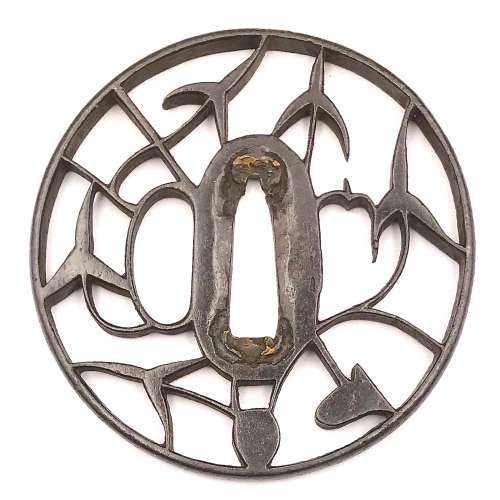 Iron tsuba of round form with design of water plantain (omodaka) and wild goose in openwork (sukashi). Slightly rounded, square rim. Copper sekigane. Kyo school. Late Muromachi period: Early 16th century (Tenbun era) [Sasano's attribution]. Height: 76.2 mm. Width: 75.8 mm. Rim thickness: 5.3 mm. Center thickness: 4.5 mm. Provenance: Sasano Masayuki Collection, № 68: "The water plantain (omodaka) first appeared as a design for sword fittings in the Heian period. From such early beginnings, this decorative plant has shared a long history with the samurai. Also known as shogun's grass (shogununso), it was held in high esteem as a symbol of victory". The same tsuba was found at Japanese Swords and Tsuba from the Professor A. Z. Freeman and the Phyllis Sharpe Memorial collections. Sotheby's, London, Thursday 10 April 1997, page 22, item 60, saying that this is a "Kyo-sukashi tsuba, early to middle Edo period (late 17th/18th century) [Sotheby's attribution], and that it represents "a small bird among omodaka and aoi plants".
Iron tsuba of round form with design of water plantain (omodaka) and wild goose in openwork (sukashi). Slightly rounded, square rim. Copper sekigane. Kyo school. Late Muromachi period: Early 16th century (Tenbun era) [Sasano's attribution]. Height: 76.2 mm. Width: 75.8 mm. Rim thickness: 5.3 mm. Center thickness: 4.5 mm. Provenance: Sasano Masayuki Collection, № 68: "The water plantain (omodaka) first appeared as a design for sword fittings in the Heian period. From such early beginnings, this decorative plant has shared a long history with the samurai. Also known as shogun's grass (shogununso), it was held in high esteem as a symbol of victory". The same tsuba was found at Japanese Swords and Tsuba from the Professor A. Z. Freeman and the Phyllis Sharpe Memorial collections. Sotheby's, London, Thursday 10 April 1997, page 22, item 60, saying that this is a "Kyo-sukashi tsuba, early to middle Edo period (late 17th/18th century) [Sotheby's attribution], and that it represents "a small bird among omodaka and aoi plants". -
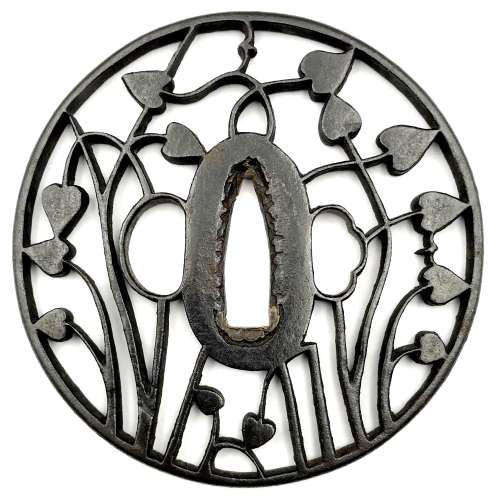 Kyo-sukashi iron tsuba of round form with design of hollyhock (aoi ) and wild geese. Slightly rounded rim. Copper sekigane. Momoyama period, late 16th - early 17th century. Height: 82.6 mm, Width: 82.1 mm, Thickness at seppa-dai: 4.5 mm. NTHK (Nihon Token Hozon Kai) certified.
Kyo-sukashi iron tsuba of round form with design of hollyhock (aoi ) and wild geese. Slightly rounded rim. Copper sekigane. Momoyama period, late 16th - early 17th century. Height: 82.6 mm, Width: 82.1 mm, Thickness at seppa-dai: 4.5 mm. NTHK (Nihon Token Hozon Kai) certified. -
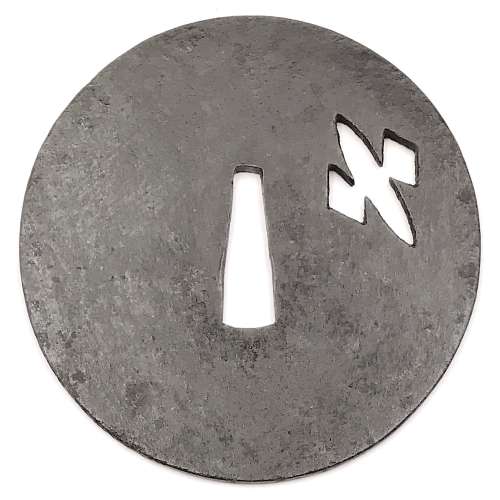 Iron tsuba of round form with design of triple diamond (matsukawa-bishi) in openwork (sukashi). Square rim. Ko-Tosho school. Nanbokucho period: Late 14th century (Oan/Eiwa era). Height: 92.3 mm. Width: 92.3 mm. Rim thickness: 2.5 mm. Center thickness: 3.0 mm. Provenance: Sasano Masayuki Collection, № 15: "Two small lozenges are attached to each end of a larger lozenge. Most Ko-tosho tsuba have inspirational designs, however this has a rather casual appearance, although it represents the unstable political situation at the time".
Iron tsuba of round form with design of triple diamond (matsukawa-bishi) in openwork (sukashi). Square rim. Ko-Tosho school. Nanbokucho period: Late 14th century (Oan/Eiwa era). Height: 92.3 mm. Width: 92.3 mm. Rim thickness: 2.5 mm. Center thickness: 3.0 mm. Provenance: Sasano Masayuki Collection, № 15: "Two small lozenges are attached to each end of a larger lozenge. Most Ko-tosho tsuba have inspirational designs, however this has a rather casual appearance, although it represents the unstable political situation at the time". -
 Ko-kinko ymagane cast tsuba of mokko form (kirikomi-mokkō-gata) with chiseled diaper pattern of double head waves on both sides and a rabbit cast and carved with its eye inlaid in yellow metal (gold or brass) on the face. Fukurin which holds together the sandwiched layers of metal (sanmai) is about 2.4 mm wide. A look-a-like tsub of oval form instead of mokko-gata is illustrated at Robert E. Haynes's Catalog #3,1982 on page 11, lot 15: "Rare design in style of Sanmai (three layers) / Wasei work. With yamagane core and heavy rim cover. The web plates are carved with double head Goto style waves and the face has a fox. The web plates were riveted at the seppadai. See Lot 4, page 8. Ca. 1350. Ht. 6.6 cm, th. 3 mm" [underscore mine]. Quality of photo is so poor that I decided not to provide it here. Muromachi (if we follow Robert) or Momoyama period. The Momoyama attribution is mostly based on a fact that "waves and rabbit" motif became most popular in Momoyama times. Size: 68.5 x 59.8 x 4.0 mm. NBTHK Certificate № 423120. This tsuba is listed at Yakiba website with the following passage: "Attributions as well as dating of this type of tsuba has been the subject debate over the years. There are those who believe these type of tsuba to be ko-Mino (early Mino School) tsuba, others believe them to be tachi-kanaguchi tsuba. Still others insist they are simply ko-kinko (early soft metal) tsuba. This tsuba was authenticated and determined to be "Ko-Kinko" by the NBTHK". Oval form tsuba with the same design can be found in this collection - TSU-0323.
Ko-kinko ymagane cast tsuba of mokko form (kirikomi-mokkō-gata) with chiseled diaper pattern of double head waves on both sides and a rabbit cast and carved with its eye inlaid in yellow metal (gold or brass) on the face. Fukurin which holds together the sandwiched layers of metal (sanmai) is about 2.4 mm wide. A look-a-like tsub of oval form instead of mokko-gata is illustrated at Robert E. Haynes's Catalog #3,1982 on page 11, lot 15: "Rare design in style of Sanmai (three layers) / Wasei work. With yamagane core and heavy rim cover. The web plates are carved with double head Goto style waves and the face has a fox. The web plates were riveted at the seppadai. See Lot 4, page 8. Ca. 1350. Ht. 6.6 cm, th. 3 mm" [underscore mine]. Quality of photo is so poor that I decided not to provide it here. Muromachi (if we follow Robert) or Momoyama period. The Momoyama attribution is mostly based on a fact that "waves and rabbit" motif became most popular in Momoyama times. Size: 68.5 x 59.8 x 4.0 mm. NBTHK Certificate № 423120. This tsuba is listed at Yakiba website with the following passage: "Attributions as well as dating of this type of tsuba has been the subject debate over the years. There are those who believe these type of tsuba to be ko-Mino (early Mino School) tsuba, others believe them to be tachi-kanaguchi tsuba. Still others insist they are simply ko-kinko (early soft metal) tsuba. This tsuba was authenticated and determined to be "Ko-Kinko" by the NBTHK". Oval form tsuba with the same design can be found in this collection - TSU-0323.
TSU-0323. Ko-kinko yamagane tsuba with waves and rabbit motif.
-
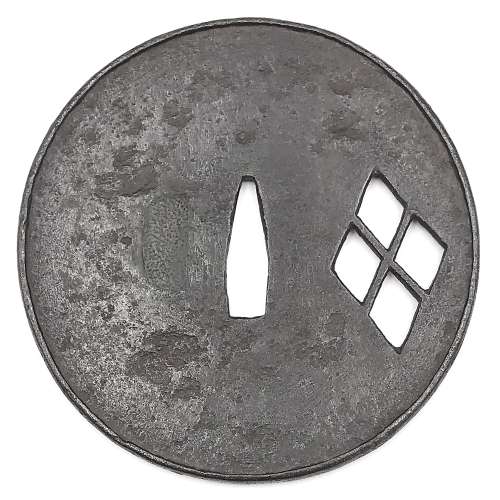 Iron tsuba of round form with design of diamond-shaped family crest (waribishi-mon) in openwork (sukashi). Bevelled, raised rim. Kozuka-hitsu-ana plugged with tin or lead. Ko-Katchushi school. Early Muromachi period: Early 15th century (Oei era). Size: Height: 89.3 mm. Width: 89.0 mm. Rim thickness: 4.3 mm. Center thickness: 2.9 mm. Provenance: Sasano Masayuki Collection, № 41: "In this tsuba, a family crest incorporating four lozenges sits upright on the right side of the nakago-ana. The straight lines of the lozenge add substance and power. Initially, the crest creates confusion regarding the age, yet the overall impression is one lacking in vigor and probably dates rather later than Nanbokucho period".
Iron tsuba of round form with design of diamond-shaped family crest (waribishi-mon) in openwork (sukashi). Bevelled, raised rim. Kozuka-hitsu-ana plugged with tin or lead. Ko-Katchushi school. Early Muromachi period: Early 15th century (Oei era). Size: Height: 89.3 mm. Width: 89.0 mm. Rim thickness: 4.3 mm. Center thickness: 2.9 mm. Provenance: Sasano Masayuki Collection, № 41: "In this tsuba, a family crest incorporating four lozenges sits upright on the right side of the nakago-ana. The straight lines of the lozenge add substance and power. Initially, the crest creates confusion regarding the age, yet the overall impression is one lacking in vigor and probably dates rather later than Nanbokucho period". -
 Ebisu drawing wakamizu, the first water drawn from a well on the New Year. Kitao Shigemasa (北尾 重政, 1739 – 8 March 1820). Signed: Shigemasa. Publisher's mark: Nishimuraya Yohachi.
Ebisu drawing wakamizu, the first water drawn from a well on the New Year. Kitao Shigemasa (北尾 重政, 1739 – 8 March 1820). Signed: Shigemasa. Publisher's mark: Nishimuraya Yohachi.References:
Jacob Pins #547 [p.217] - Ebisu drawing wakamizu, the first water drawn from a well on the New Year. TNM II (Tokyo National Museum Catalogue vol. 2) #1373.
-

Kitagawa Tsukimaro (Kikumaro): 喜多川 月麿, fl. c. 1794–1836.
Mother is playing with her child: they left playing with shadow lantern for freeing a turtle (Hojo-e, or "Rite for the Release of Living Beings").Signed: Tsukimaro hitsu (月麿筆); Publisher's mark; censor's seal: Kiwame + Yamaguchiya Tôbei gyōji seal (1811-14).
-
 Kikukawa Eizan (菊川 英山, 1787 – July 17, 1867) Signed: Eizan hitsu (英山筆)
Kikukawa Eizan (菊川 英山, 1787 – July 17, 1867) Signed: Eizan hitsu (英山筆)Jacob Pins #972/p.341. Leiden, Rijksmuseum voor Volkenkunde.
"The Lovers Miura-ya Komurasaki and Shirai Gonpachi: Tragic love stories taken from real life and dramatized were a staple of stage and print; the darkly romantic combination of desire and death was hugely popular in the eighteenth century. Hirai Gompachi was a warrior of the Tottori fief in western Japan who fled to Edo after committing a murder. He was apprehended and sentenced to death in 1679. His distraught lover, the courtesan Komurasaki, committed suicide at his grave." [MET]
.
-
 Artist: Katsukawa Shunkō [勝川 春好] (Japanese, 1743 – 1812).
Artist: Katsukawa Shunkō [勝川 春好] (Japanese, 1743 – 1812).Actor: Matsumoto Kōshirō IV [[松本幸四郎]; other names: Omegawa Kyōjūrō, Ichikawa Komazō II, Ichikawa Somegorô I, Ichikawa Takejūrō, Segawa Kinji, Segawa Kingo] (Japanese, 1737 – 1802).
Signed: Shunkō ga. Size: Hosoban; 14 x 33 cm. SOLD -
 Katsukawa Shun'ei. The Sumo Bout between Yotsuguruma (right) and Yamaoroshi (left). Date: 1800 or 1805/06. Similar sheet can be found at Edo Tokyo Museum. Size: Vertical Ōban. Sumo wrestler Yotsuguruma Daihachi (1772 - 1809) first appeared in the records of national tournaments in winter of 1794. Then he lost 3 matches and won zero. He first won in the spring tournament of 1797 in a match against maegashira (the fifth-highest rank of sumo wrestlers) named Kougamine. Yamaoroshi Gengo (born 1762) came in at the winter tournament of 1799 . He was much more successful in his career than Yotsuguruma, but he had never won a tournament. It was the time of great Raiden, who won most of them. In the spring tournament of 1800 Yotsuguruma and Yamaoroshi fought against each other for the first time. Yotsuguruma lost. The next time they met on the ring was at the winter tournament of 1805, and again in 1806. Both matches were won by Yamaoroshi. Yamaoroshi retired in 1809; Yotsuguruma died in 1809.
Katsukawa Shun'ei. The Sumo Bout between Yotsuguruma (right) and Yamaoroshi (left). Date: 1800 or 1805/06. Similar sheet can be found at Edo Tokyo Museum. Size: Vertical Ōban. Sumo wrestler Yotsuguruma Daihachi (1772 - 1809) first appeared in the records of national tournaments in winter of 1794. Then he lost 3 matches and won zero. He first won in the spring tournament of 1797 in a match against maegashira (the fifth-highest rank of sumo wrestlers) named Kougamine. Yamaoroshi Gengo (born 1762) came in at the winter tournament of 1799 . He was much more successful in his career than Yotsuguruma, but he had never won a tournament. It was the time of great Raiden, who won most of them. In the spring tournament of 1800 Yotsuguruma and Yamaoroshi fought against each other for the first time. Yotsuguruma lost. The next time they met on the ring was at the winter tournament of 1805, and again in 1806. Both matches were won by Yamaoroshi. Yamaoroshi retired in 1809; Yotsuguruma died in 1809. -
 Katsukawa Shun'ei (勝川 春英; 1762 – 1819).TITLE: Sawamura Sôjûrô III as Kakogawa Honzô.SERIES: Kanadehon Chūshingura (Kana practice book: Treasury of the loyal retainers").DATE: 1795Signed: Shun'ei ga (春英画). Publisher: Iwatoya Kisaburō, Marks 173/p.169. Vertical Ōban: 14.75 x 9.625 inchOn 4th lunar month of 1795 Sôjûrô plays the roles of En'ya Hangan and Kakogawa Honzô in the drama "Kanadehon Chûshingura" at Miyakoza theater in Edo.
Katsukawa Shun'ei (勝川 春英; 1762 – 1819).TITLE: Sawamura Sôjûrô III as Kakogawa Honzô.SERIES: Kanadehon Chūshingura (Kana practice book: Treasury of the loyal retainers").DATE: 1795Signed: Shun'ei ga (春英画). Publisher: Iwatoya Kisaburō, Marks 173/p.169. Vertical Ōban: 14.75 x 9.625 inchOn 4th lunar month of 1795 Sôjûrô plays the roles of En'ya Hangan and Kakogawa Honzô in the drama "Kanadehon Chûshingura" at Miyakoza theater in Edo. -
 Print by Katsukawa Shun'ei that presumably depicts a kabuki actor Ichikawa Monnosuke II. I was not able to find any reference of the image. Size: Hosoban. SOLD
Print by Katsukawa Shun'ei that presumably depicts a kabuki actor Ichikawa Monnosuke II. I was not able to find any reference of the image. Size: Hosoban. SOLD -
 Katsukawa Shun'ei. Signed: Shun'ei ga (春英画). Vertical Ōban. No reference whatsoever. Unidentified play, actors, roles, year, theatre. SOLD
Katsukawa Shun'ei. Signed: Shun'ei ga (春英画). Vertical Ōban. No reference whatsoever. Unidentified play, actors, roles, year, theatre. SOLD -
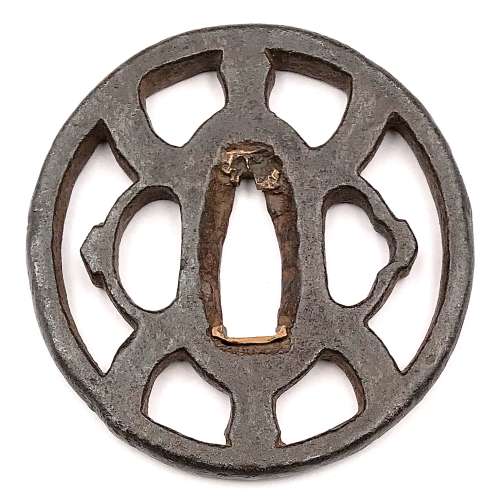 Iron tsuba of round form with design of the Chinese character for cinnabar (shu-no-ji) in openwork (sukashi). Round-cornered rim. Copper sekigane. Kanayama school. Early Edo period: Early 17th century (Kan-ei era). Height: 70.0 mm. Width: 69.6 mm. Rim thickness: 6.8 mm. Center thickness: 5.8 mm. Provenance: Sasano Masayuki Collection, № 139: "Many areas have a coarse texture and strong tekkotsu, with the thickness of the metal graduating from the rim to the seppa-dai. The combined color of the iron and motif date this work to the early Edo period".
Iron tsuba of round form with design of the Chinese character for cinnabar (shu-no-ji) in openwork (sukashi). Round-cornered rim. Copper sekigane. Kanayama school. Early Edo period: Early 17th century (Kan-ei era). Height: 70.0 mm. Width: 69.6 mm. Rim thickness: 6.8 mm. Center thickness: 5.8 mm. Provenance: Sasano Masayuki Collection, № 139: "Many areas have a coarse texture and strong tekkotsu, with the thickness of the metal graduating from the rim to the seppa-dai. The combined color of the iron and motif date this work to the early Edo period". -
 Iron tsuba of round form with design of hatchet executed in openwork (sukashi) and three fan panels motif on both sides carved in low relief (sukidashi-bori). Designs on the fan panels - face: bellflower, plum blossom in mist, grass leaves; - back: clouds, grass, and half plum blossom in mist. Copper sekigane. Koga-hitsu-ana probably cut out on a later date. Kamakura or kamakura-bori school. Edo period. Height: 83.8 mm, Width: 82.2 mm, Thickness at seppa-dai: 3.2 mm. NBTHK certificate № 4005500: Hozon (worthy of preservation).
Iron tsuba of round form with design of hatchet executed in openwork (sukashi) and three fan panels motif on both sides carved in low relief (sukidashi-bori). Designs on the fan panels - face: bellflower, plum blossom in mist, grass leaves; - back: clouds, grass, and half plum blossom in mist. Copper sekigane. Koga-hitsu-ana probably cut out on a later date. Kamakura or kamakura-bori school. Edo period. Height: 83.8 mm, Width: 82.2 mm, Thickness at seppa-dai: 3.2 mm. NBTHK certificate № 4005500: Hozon (worthy of preservation).


